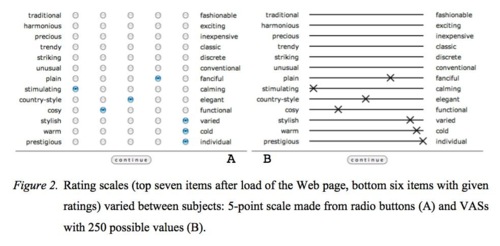In their article “Why semantic differentials in Web-based research should be made from visual analogue scales and not from 5-point scales” that is to appear in the journal Field Methods next week Funke and Reips show how the response options given to the respondents influences the way they understand what to do with the question. A small number of response options implicitly conveys the message that roughly estimated answers are sufficient, whereas a large number of response options can be understood as an instruction to maximize cognitive efforts and provide an exact answer.
To test this hypothesis, Funke and Reips compared two versions of semantic differentials, the prime method for assessing multiple aspects of one psychological construct on a single (web) page. One version was made up from Visual Analogue Scales, the other one from 5-point scales, see Figure.

Respondents adjusted their ratings with Visual Analogue Scales more often to maximize the precision of answers, which had a beneficial effect on data quality. No side effects like differences in means, higher dropout, more nonresponse, or higher response times were observed.
The current paper continues a series of articles by the authors investigating measurement in online data collection, particularly the use of visual analogue scales. See for example http://iscience.deusto.es/2008/04/01/reips-u-d-funke-f-2008-interval-level-measurement-with-visual-analogue-scales-in-internet-based-research-vas-generator-behavior-research-methods-40-699-704/
